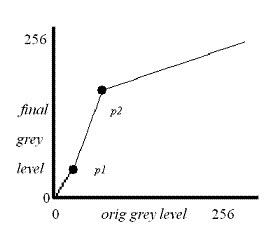Contrast Stretching
Low
contrast images can result from poor illumination, lack of dynamic range in the
image sensor, or wrong setting of the lens aperture. The result of a low contrast image is that not all of the
possible grey level range is used and possibly only a relatively small part of
the possible grey level range is used.
By too small, it is meant that
the range of grey levels used in the image out of the possible that could be
used is not large enough to clearly capture the detail and variation in the
original scene.
| Original | Constrast Stretched |
Contrast stretching, will take an image and
produce another image that uses more of the possible grey levels. For example, you may have an image with 256
possible grey levels that only uses grey levels from 0 to 120. You can use contrast stretching to produce
an image that uses all 256 possible grey levels, and thus “stretches” the range
of grey levels.
The act of
contrast stretching can be describe by a mapping or transformation of original
to final grey levels. For example. a
typical transformation involves choosing 2 grey level correspondences and
“stretching” between those values as discussed below and illustrated by the
diagram.
Example
Contrast Stretching:
Suppose we designate a grey level in the original image by orgin j and a grey level in the final
contrast stretched image as final j. Suppose that we have a possible of 256 grey levels and we set up
the following two original/final grey level correspondences to stretch between:
p1 =
(orig 10, final 50) and
p2 = (orig 40, final 170)
Then, the contrast stretch mapping/transformation is
described by the following diagram:

For
consistency, the orig value of p1 <= orig value of p2 and final value of p1 <= final value of p2.
